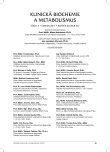Exercise-induced rhabdomyolysis – frequent cause of false diagnosis
Authors:
J. Racek; V. Petříková; D. Rajdl
Authors‘ workplace:
Ústav klinické biochemie a hematologie Lékařské fakulty UK a Fakultní nemocnice v Plzni
Published in:
Klin. Biochem. Metab., 25, 2017, No. 2, p. 72-76
Overview
Objective:
To describe cases of exercise-induced rhabdomyolysis and warn of the most frequent false diagnoses.
Design:
Case reports with evaluation of laboratory results and analysis of etiopathogenesis of this condition.
Settings:
Department of Clinical Biochemistry and Hematology, Faculty of Medicine, Charles University and Faculty Hospital, Alej Svobody 80, 304 60 Pilsen (Czech Republic).
Material and Methods:
Case reports and their analysis.
Results:
The paper describes seven cases of exercise-induced rhabdomyolysis; all patients were examined and treated in the Faculty Hospital in Pilsen. In most of the cases the condition was evaluated falsely during the first contact with the physician. Etiopathogenesis of this condition is described on the basis of case reports analysis and the most frequent cases of false diagnosis are shown.
Conclusion:
Exercise-induced rhabdomyolysis can arise after an inappropriate muscle load, especially in less trained persons. Incorrect evaluation of laboratory results can lead to diagnosis of liver disease and hematuria.
Keywords:
rhabdomyolysis, muscle load, liver disease, hematuria.
Sources
1. Cervellin, G., Comelli, I., Lippi, G.: Rhabdomyolysis: historical background, clinical, diagnostic and therapeutic features. Clin. Chem. Lab. Med., 2010, 48(6), p. 749 – 756
2. Bosch, X., Poch, E., Grau J. M.: Rhabdomyolysis and acute kidney injury. N. Engl. J. Med., 2009, 361(1), p. 62 – 72
3. Colleen Bhalla, M., Dick-Perez, R.: Exercise induced rhabdomyolysis with compartment syndrome and renal failure. Case Reports Emerg. Med., 2014, http://dx.doi.org/10.1155/2014/735820
4. Rosenberg, J.: Exertional rhabdomyolysis: Risk factors, presentation, and management. Athletic Therapy Today, 2008, 13(3), p. 11 – 12
5. Giannoglou, G. D., Chatzizisis, Y. S., Misirli, G.: The syndrome of rhabdomyolysis : Pathophysiology and dia-gnosis. Eur. J. Intern. Med., 2007, 18, p. 90 – 100
6. Kim, J., Lee, J., Kim, S., Ryu K. H., Cha, K. S., Sung, D. J.: Exercise-induced rhabdomyolysis mechanisms and prevention: A literature review. J. Sport Health Sci., 2015, http://dx.doi.org/10.1016/j.jshs.2015.01.012
7. Hannah-Shmouni, F., McLeod, K., Sirrs, S.: Recurrent exercise-induced rhabdomyolysis. Canad. Med. Assoc. J., 2012, 184(4), p. 426 – 430
8. Pistner, K. B.: Treatment of exercise-induced rhabdomyolysis. Undergraduate Res. J. Human Sci., 201612, http://www.kon.org/urc/v12/pistner.html
9. Tran, M., Hayden, N., Garcia, B., Tucci, V.: Low-Intensity Repetitive Exercise Induced Rhabdomyolysis. Case Reports Emerg. Med., 2015, http://dx.doi.org/10.1155/2015/281540
10. Thoenes, M.: Rhybdomyolysis: When exercising becomes a Risk. J. Pediatr. Health Care, 2010, 24, p. 189 – 193
11. Lee, G.: Exercise-induced rhabdomyolysis. Rhode Island Med. J., 2015, p. 22 – 24
12. Pierson, E. H., Bantum, B. M, Schaefer, M. P.: Exertional rhabdomyolysis of the elbow flexor muscles from weight lifting. Physical Med. Rehab., 2014, 6, p. 556 – 559
Labels
Clinical biochemistry Nuclear medicine Nutritive therapistArticle was published in
Clinical Biochemistry and Metabolism

2017 Issue 2
Most read in this issue
- Exercise-induced rhabdomyolysis – frequent cause of false diagnosis
- 23 cases of Metformin-induced Metabolic Lactic Acidosis in Patients treated with Metformin
- MedPed project in Czech Republic
- Interpretation difficulties in electrophoresis and immunofixation findings in patients with multiple myeloma after autologous transplantation
